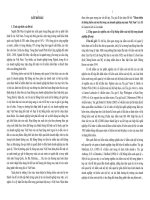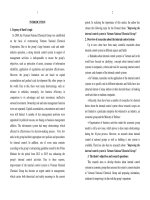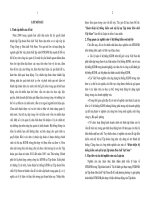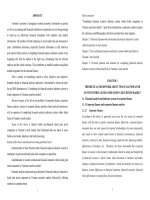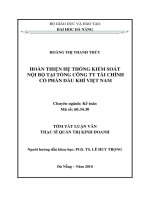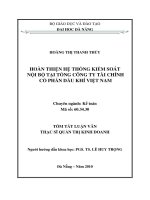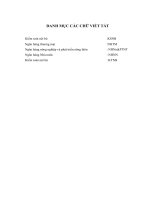tóm tắt tiếng anh hoàn thiện hệ thống kiểm soát nội bộ tại tại tập đoàn hoá chất việt nam
Bạn đang xem bản rút gọn của tài liệu. Xem và tải ngay bản đầy đủ của tài liệu tại đây (130.64 KB, 12 trang )
1
INTRODUCTION
1. Urgency of thesis’s topic
In 2009, the Vietnam National Chemical Group was established
on the basis of restructuring Vietnam National Chemical
Corporation. Due to the group’s large business scale and multi-
industry operation, a strong internal control system in support of
management activities is indispensable to ensure the group’s
objectives, such as: protection of assets, assurance of information
reliability, application of regulations and operation effectiveness.
However, the group’s formation was not based on capital
accumulation and gradual scale development like other groups in
the world. Due to this, there were many shortcomings, such as:
reliance in subsidies, monopoly, low business efficiency in
comparison to its advantages and state investment, ineffective
outward investment. Ownership role and state management function
were not separated. Capital accumulation, concentration and control
were still limited. A number of key management positions were
appointed for political reasons, not basing on business management
abilities. The information system had many shortcomings which
affected its effectiveness for decision-making process. Very few
units in the group had their appropriate own policies and procedures
for internal control. In addition, one of seven main contents
according to the group’s restructuring guideline issued by the Prime
Minister for the period from 2012 to 2015 was enhancing the
group’s internal control activities. Due to these reasons,
improvement of the internal control system in Vietnam National
Chemical Group has become an urgent matter in management,
which carries both theoretical and reality meanings in the current
2
period. In realizing the importance of this matter, the author has
chosen the following topic for the Dotoral thesis "Improving the
internal control system in Vietnam National Chemical Group".
2. Overview of researches about the internal control system
Up to now, there have been many scientific researches about
internal control system in different aspects and fields:
+ Rationales about internal control systems in Vietnam and in the
world have focused on clarifying concepts about internal control
systems in companies, criteria and tools for assessing internal control
systems and elements of the internal control systems
+ In Vietnam, researches on the application of the internal control
systems in a specific unit in different industries and fields have also
attracted interest of many authors in their doctoral theses: in banking
credit activities or medium companies.
+ Recently, there have been a number of researches for doctoral
theses about the internal control system whose research scopes are
not limited to a particular enterprise but widened to an industry, an
economic group and the Ministry of Defence
+ Organization of business activities under the economic group
model is still a new issue, which proves to have many shortcomings
during the 10-year process. However, no research about internal
control at national groups as well as building it into system is
available. There has also been no reasearch about "Improving the
internal control system in Vietnam National Chemical Group".
3. The thesis’s objectives and research questions:
This research aims to develop theories about internal control
systems in economic groups then assesses the system’s current situation
in Vietnam National Chemical Group and proposing orientations,
solutions for improving it in line with the group’s operations
3
Research questions: In achieving the above research objectives,
research questions were given accordingly (see research framework)
4. The objective’s objectives and research scope
This thesis focuses on researching the internal control system in
Vietnam National Chemical Group (both the parent company and its
subsidiaries)
5. The thesis’s research methodologies
- Methodologies of dialectical/historical materialism under
Marxism-Leninism are applied for sociological researches. The
thesis applies methods of generalization, statistics, analysis of basic
principles about internal control systems in textbooks and documents.
- Survey, observation, interview methods: The author designs the
questionnaire for survey and carries out intensive interviews.
- Data processing method: from results of survey, observation and
interviews , the author designs 14 charts for description, evaluation,
statistics and comparison.
- Data sources: The author used primary and secondary data.
6. New contributions of the thesis
- About theoretical aspect: building internal control model as the
theoretical framework for researching the internal control system at
Vietnam National Chemical Group. It brings up characteristics of
organizational activities and capital define the design and operation of
the group’s internal control system. From the reality of organizing
internal control systems in economic groups in the world (such as the
U.S, China, Japan, Korea), the thesis draws some lessons for Vietnam.
- About reality aspect: basing on reality survey, analysis and
assessment, the thesis proposes a group of solutions for improving
the internal control system in Vetnam National Chemical Group.
4
7. The topic’s research framework and structure
Chart 1.1. The topic’s research framework
Answering the first research
question:
Characterisics of economic groups
concerning internal control system’s
design and operation? Elements of
internal control system in economic
groups? International experience
about internal control system in
economic groups in some countries,
thus drawing lessons for Vietnam
Answering the second research
question:
Reality of internal control system’s
design and operation in Vietnam
National Chemical Group?
Chapter 3
Orientations and solution for
improving the internal control
system in Vietnam National
Chemical Group
Answering the third research
question:
What group of solutions needed to
improve the internal control system
in Vietnam National Chemical Group
in accordance with its objectives
Chapter 2
Reality of the internal control
system in Vietnam National
Chemical Group
Chapter 1
General theory about internal
control system and internal control
system in economic groups
5
C
HAPTER 1: GENERAL THEORY ABOUT INTERNAL
CONTROL SYSTEM AND INTERNAL CONTROL SYSTEM
IN ECONOMIC GROUPS
1.1 Overview of control and internal control in management
1.1.1 Control in management
Control is closely related to the management and it plays an
important role in manager’s decision making. It is one of the five
functions of management including: Goal setting and planning,
operation organizing, coordinating and control. Through control, the
managers recognize the shortcomings in the organizational system to
propose timely corrective measures. Through control, the managers
get sufficient information to make appropriate decisions in order to
adapt to the environment and achieve their objectives
1.1.2 Classification of control
By object of control: for prevention, detection and regulation. By
scope of control: internal and external controls. By content of control:
organizational and accounting controls. By management subject of
control: direct and indirect controls.
1.1.3 Internal control
The internal control structure of COSO (The Committee of
Sponsoring Organizations) can be generalized by the following
diagram "Internal control is a process governed by managers, board
of directors and the unit’s staff. It is established to provide a
reasonable assurance to achieve the following objectives: Reliability
of financial report; compliance with laws and regulations; efficiency
of operations [111 , p. 186]
6
Chart 1.3: Structure of internal control according to COSO
1.2 Internal control systems in company
1.2.1 The nature of internal control system
The International Federation of Accountants ( IFAC ) has
offered this definition: "The internal control system is a system of
policies and processes designed to achieve four objectives: protection
of assets, assurance of information’s reliability, compliance of laws
and regulations and efficiency of operation[ 72.82 ]. This definition
mentions relatively all aspects of internal control system and
emphasizes the objectives of ensuring the operation’s efficiency in
compliance with the law and regulation, reliability of information and
assets’s safety. This concept also coincides with the viewpoint of
Alvin A.rens. Having high generalization characteristics, it can be
used for internal control system’s researches in various fields. It is
similar in nature with the word “system” in Vietnamese, which
means a whole entity of ideologies, principles, rules coherently
linked together. Thereby it is applied by the author in studying the
internal control system in Vietnam National Chemical Group
I.C
Reliability of
financial reports
Compliance of
laws and
regulations
Efficiency of
operations
Control
environment
Risk
assessment
Control
activities
Information
and
communication
Monitoring
7
1.2.2 Elements of Internal Control System
With the approach that the internal control system is a unified
entity of the elements of the same type and function closely linked
together, the author chooses the IFAC’s viewpoint as a basis to
determine elements in the internal control system in economic groups
in general and Vietnam National Chemical Group in particular as
follows: control environment, information systems (accounting
system) and control procedures. Organizational model of internal
control system is outlined in the chart below
Chart 1.4: Organizational model of internal control system
1.3 Internal control system in economic groups
1.3.1 Overview of economic groups
1.3.1.1 Concept and roles of economic groups
From different concepts, author comes up with a concept of an
economic group as below: An economic group is an entity of
IC System
Control environment
- Management
Specification
- Organizational
Structure
- HR Policies
- Planning activities
- Control Committee
- Internal Audit Division
- External Control
Environment
Information System
- Document system
- Account system
- Booking system
- Reporting system
Control Procedure
- Principle of work
and responsibility
assignment
- Non-concurrent
principle
- Principle of
authorization and
ratification
Protection of
assets
Assurance of
reliability of the
information
Assurance of
compliance with
laws and regulations
Assurance of
efficiency of
operation
Control Policies
Control
procedures
8
economic subjects including the parent company and its units/
member companies with legal entity status that share an ownership
relationship or a long-term relation in terms of economic benefits,
technology, markets, other services and operations strategy in
different areas in order to enhance accumulation, concentration,
increase competitiveness and to maximize benefits.
The role of economic groups is very important: Groups allows
mobilization of material resources , labor and capital in society;
linkage to protect the domestic production; expansion in the global
market; overcoming of capital limitations for individual companies;
promotion of research, development and application of new science
and technology, widespread exchange of information and experience
and improvement of economical efficiency
1.3.1.2. Classification of economic groups:
By the method of formation: horizontal affiliation, vertical
affiliation, mixed affiliation. By ownership: private group, public
group, multi-possession group. By the nature of the affiliation:
“hard” and “soft” affiliation. By the specialization characteristics:
group with few business fields, multi-industry group. By the
business scope: domestic group, transnational Group
1.3.2 Characteristics of economic groups influencing the design
and operation of internal control system in a group
1.3.2.1 Group organizational and operational characteristics
regarding the design and operation of internal control system
- In terms of legal status, an economic group has no legal entity
status it is only a combination of companies with legal entity status.
- The organizational structure of groups is very diverse with no
model pattern. But groups share some common features in
management structure: according to the multi- block model in which
a company holds a key role.
- In term of the business scale and scope: most groups operate in a
very large scale and wide range
- In term of affiliation and capital management: the main links in
a group is through capital investment relations
- In term of business sector: the groups carry out diversified and
multi-sector operation to diversify risks
- In term of ownership: multi-mode of ownership, parent company
and subsidiaries
9
1.3.2.2 Characteristics of capital in an economic group regarding the
design and operation of internal control system
- Diversity of capital ownership in group
- Distinction in ownership and operation of capital to a certain extent.
- Transparency in adjustment of capital structure
- Subject to regulation of the financial management mechanism
- High-risk characteristic of capital in the group
1.3.3 Distinction between internal control systems in a group and
an individual company
- Distinction between a group and an individual company
- Distinction between internal control system in a group and in an
individual company
1.4 Experience of the internal control systems in some
international economic groups
1.4.1 Overview of the internal control systems in some international
economic groups
In the U.S: the organizational structure of groups is as follows:
the parent company establishes a Board of Directors, the Board - on
behalf of the company- has the right to decide all matters related to
identifying and implementing goals, tasks and rights of the company.
The Board of Directors includes internal members and independent
members. The Board usually forms several committees in which the
members of the Board are in charge of, including: finance, human
resource and audit committees. The control of groups in the United
States focuses on three aspects: cost, capital and debt
In China: the group and parent company carry out both capital
management and direct production and trading functions. The parent
company directly assigns representatives to the management bodies of
respective subsidiaries with governing and coordinating power.
Internal audit is an important element in the group’s financial
supervision system. However, to boost the efficiency, it is necessary
to clearly define the relationship and responsibilities of this unit with
the Board of Supervisors
In Japan: organizational structure in the groups, parent companies
and subsidiaries share quite close links in exchange of informations,
strategies, business plans through the Board of Directors. The human
resource policies in groups apply the management mode for « lifetime
recruitment» which encourages everyone in the groups to do their best
for survival and for development of the groups
10
In Korea, the Chairman’s responsibilities are equivalent to these
of the Board members. In each group, there is a corporate office
directed by the President with the function of strategy planning and
development, coordination of joint activities. This, however, is not an
independent legal entity. In the internal control system, the audit
committee reports to the Board and owners about the operations of
subsidiaries. The “pyramid-style” human resource policies always
push all members to strive for high results in their position.
1.4.2 Some lessons for the internal control systems in Vietnamese
economic groups
An audit committee is necessary for the control environment. A
unit of internal audit is required under the Board of Supervisors at all
levels of the group to provide early warnings of risks, financial
monitoring and assessment of effectiveness and efficiency of the
internal control system.The State-owned groups (public groups) need
a clear distinction between the function of business management and
public administration, between objectives of business efficiency and
state management for economic regulation. The parent company
assigns representatives to its member companies. For human resource
policies, the management mode for « lifetime recruitment» in Japan
should be applied flexibly in combination with the pyramid –style
policies in Korean to push all members to strive for high work results
Conclusion for chapter 1
In chapter 1, thesis clarifies the following contents:
- Specialization to clarify basic theoretical issues about internal
control systems in companies Analysis of different opinions about
internal control system, thereby offering a organizational model of
internal control system as the theoretical framework for studying the
internal control system in Vietnam National Chemical Group
- Analysis of the group’s organizational and operational
characteristics influencing the design and operation of the internal
control system. Distinctions between internal control system in
groups and individual companies are presented to offer a deeper view
on the design and operation of internal control system in groups.
- Study of experience in organizing internal control systems in
some economic groups in the world (such as the U.S, China, Korea)
to draw some lessons for Vietnamese groups.
11
CHAPTER 2: REALITY OF THE INTERNAL CONTROL
SYSTEM IN VIETNAM NATIONAL CHEMICAL GROUP
2.1 Chacteristics of Vietnam National Chemical Group regarding
the selection of research object
2.1.1 The establishment and development of Vietnam National
Chemical Group
The Vietnam National Chemical Corporation was established
following Regulation No. 835/TTg dated Dec 20, 1995 of the Prime
Minister on the basic of merging two corporations: Fertilizers and
Basic Chemicals Corporation and Industrial and Consumer Chemicals
Corporation. In 2006, Vietnam National Chemical Corporation
changed its operation model into the form of parent company-
subsidiaries. In 2009, the Prime Minister approved the pilot scheme on
the establishment of Vietnam Industrial Chemical Group and the
decision on the establishment of Vietnam National Chemical Group as
the parent company. In 2010, the parent company - Vietnam National
Chemical Group - was changed into a Limited Company owned by the
State according to a decision by the Prime Minister.
2.1.2 Characteristics of the Vietnam National Chemical Group
affecting the internal control system
2.1.2.1 Operational characteristics of Vietnam National Chemical
Group
- About the group’s establishment method: based on re-
arrangement, restructuring of Vietnam National Chemical Corporation
- About legal status, Vietnam National Chemical Group does not
have legal entity status; only the parent company and its subsidiaries
have such status
- About simple organization structure: the parent company is the
level-1 company; its subsidiaries are level-2 companies
- About affiliation and ownership: subsidiaries and affiliates in
the group exit under the three following forms: limited company,
joint stock company whose over 50% of charter capital owned by its
parent company and joint stock company whose under 50% of
charter capital owned by its parent company.
- About scale, the group enjoys scale advantage in terms of
capital, assets, human resources and number of subsidiaries.
- About varied business scopes and fields: the groups operates in
4 main sectors and two other sectors related into main sectors
12
2.1.2.2 Capital characteristics of Vietnam National Chemical
Group
Capital is monitored by representatives and adjusted according to
different period. Capital is mobilized in many ways: issuance of
bond, treasury bill, promissory notes; borrowing from financial
institutions, other financial organizations and individuals outside the
group. Outward investment must conform to legal regulations in
accordance with the parent company’s strategy and planning
2.1.3 Selection of surveyed companies under the group
* Survey subjects: The parent company and member companies
of the group (30/47 companies accounting for 63,8%) as
representatives concerning the degree of capital ownership and
trading sector, [Annex 13]
*Design of questionnaires: At the parent company: 112 questions
[Annex 20]. At the member companies: 128 questions [Annex 12]
*Survey objectives, to collect information about the group’s
internal control system
*Survey methods: Questions in the survey form include both open
and closed types, coupled with interviews and observation to evaluate
the existing level of internal control system
2.2 Design and operational reality of the internal control system
in Vietnam National Chemical Group
2.2.1 Control environment’s reality in Vietnam National Chemical Group
- About management: internal control is highly appreciated in the
parent company. Though having capital trading function,
management bodies have not undergone appropriate risk research
and evaluation processes.
- Organizational structures in parent and member companies are
suitable. However, a number of units in member companies still carry
out concurrent functions and there is no corresponding job
description for each position.
- Human resource policies are established in parent and member
companies. But there is a lack of connection between training
instittues and companies in the group’s human resource plan.
- Companies take the initiative and pay attention to planning
activities. However, the parent company’s co-ordination of planning
among member companies is unsatisfactory. Instead of being active
in plan buildings, member companies base their plans on previous
13
term’s planning. The majority of staff has not undergone planning
training, thus resulting in loose connections between plans. Most
companies do not carry out risk assessment in the planning process.
- Control mechanism is organized; the control committees in parent
and member companies were restructured. However, operation of
control committees is not effective. Specific rules on reward and
penalty are unavailable.
- Internal control systems are not built in parent and member
companies
- Many shortcomings exist for external elements of legal documents:
capital building for state economic groups are limited; state capabilities
in management and supervision are outpaced by reforms in financial
mechanisms for state companies and state economic groups.
2.2.2 Reality of information system in Vietnam National Chemical
Group
2.2.2.1 Information system of companies
Information is mainly exchanged via documents, phones and
network. However, the information system does not assist management
bodies in identifying and coping with risks as well well maximizing
business opportunities. No appropriate mechanism is in place for
outside information collection.
2.2.2.2 Accounting information system
Attention is given to the parent and member companies’
accounting information systems, which meet the management
requirements. At member companies, however, the formation of
document rotation process is not specified by documents; delegation
on document signing is unclear.
Concerning the account system; a number of companies do not
use their accounts appropriately; accounts do not provide assistance
for preparing company’s management report.
There is a lack of attention regarding the record and report system
2.2.3 Reality of control procedures in Vietnam National Chemical
Group
2.3.3.1 Principle control procedures in Vietnam National Chemical
Group
Control procedures are established but focus is only given on
regular activities, not abnormal ones. Objective control procedures
are not applied such as suggestion box. No method available for
14
enhancing staff’s sense of self-criticism. No specific regulation in
documents about authorization of document signing is in place in the
majority of companies.
2.2.3.1 Reality of applying basic control principles in design and
peration of control procedures in Vietnam National Chemical Group
- Principles of work and responsibility assignment: carried out between
the Board of Directors, Member Council and Board of Management in
the parent and member companies (one-member limited and joint stock
companies). They are implemented properly between departments and
for subordinate units
- Non-concurrent principle: most companies in the group do not clearly
regulate non-concurent works.
- Principles of authorization and ratification: carried out at the parents
and member companies as well as subordinate units. Authorized
individuals must implement work approval and must be held responsible
for what they approved.
2.3.3.3 Reality of controlling principle activities in Vietnam National
Chemical Group
At the parent company: Concerning capital control, financial
regulations are established in most companies. However, there is no
appropriate regulation on capital control in the group. Concerning
control of representatives, control regulations are in place but many
shortcomings exist: many rights are assigned without an effective
control mechanism; remuneration is not reasonable; concurrent
positions exit; there is no frequent information exchange between
representatives and the parent company.
At member companies:
- Purchasing control: criteria and procedures for evaluating and
selecting suppliers are not regulated by written documents; selection
is still based on relations, thus sometimes resulting in many risks in
purchasing process.
- Sales and payment collection control: most one-member limited
companies do not have sales promotion policies, unlike joint stock
companies with better, more effective and flexible sale policies.
Control procedures from placing order, putting goods out, making
invoice, delivery and payment are cumbersome with many stages;
therefore application is still slow. Co-ordination is missing between
different units in carrying out their work.
15
- Inventory control: surveyed companies have not established
inventory procedures by documents, which makes it hard for assigning
works and checking inventory properly. A number of companies do
not review the current status of their materials and inventories for
categorizing unsold goods/materials with poor quality and having
appropriate solutions.
- Fixed assets control: companies have yet paid attention to assets
numbering or coding, which creates difficulties for asset control and
classification. In addition, companies in have not planned on building
and maintaining a system of daily and unusual reports about usage and
current status of fixed assets.
Control of discharge into the environment: the task of
environment control in the group is carried out well. However a few
companies still do not pay attention to controlling environmental
waste. They had to pay fines to the government for environmental
pollution. When pollution occurred, timely recovery measures were
not carried out, resulting in serious consequences.
2.3 Assessment of the reality of internal control system in
Vienam National Chemical Group.
2.3.1 Strong points of the internal control system in Vietnam
National Chemical Group.
- Control environment: companies in the groups have favourable
internal control environments to maintain and organize the internal
control systems with a view to bringing into plays its effectiveness in
management activities. Leaders at parent and member companies
demonstrate regular concerns, direction, and willingness to think, do and
approach new knowledge in management in general and in control of
activities in particular.
- Accounting information system: accounting activities are carried
out quite in sync with business characteristics in each filed of
operation.
- Control procedures: companies have carried out activities and
operations with complementary effects in order to create a continuous
internal control system.
2.3.2 Some shortcomings of the internal control system in Vietnam
National Chemical Group.
- Control environment: Reagrding management, awareness about
control of a number of leaders in member companies is still
16
incomplete. Regarding organizational structure, concurrent and
overlapping situations in functions, responsibilities still exist.
Appointment of responsibilities is not regulated by specific
documents. Regarding human resource policies, they have not
displayed effectiveness. There are no policies to encourage
employees’ devotion to their companies. Regarding planning,
initiative has not been taken in assessing the reality for planning.
Planning procedures are not constructed properly. The quality of
planning activities is not good with the lack of synchronization.
Regarding internal audit, such important system has yet been built by
companies in the groups.Regarding control system, its role and
responsibilities have not been brought into play and no proper training
is available. Regarding control from the outside, control mechanism
do not focus on control of the implementation of state ownership.
There is a lack of consistency, synchronization about the state’s
management role with focus on trivial and separate matter only.
- Information system: communication of information in the
group’s companies are not smooth or even slow at times. There are
also many shortcomings in accounting information system.
- Control procedures: incomplete control procedures and
violations in designs of procedures are still in place.
Regarding control of some basic activities: In the parent
company, control of representatives proves to be not effective and
does not bring its assigned responsibilities and role into full play.
Regarding capital control: no suitable regulations about capital
control in the group is available; the groups’s financial capability is
weak. In member companies: Purchasing control: there are no
effective control policies and procedures for suppliers; Sales and
collection control, control of liabilities and markets is not effective
enough; Investory control: inventory procedures have not been
designed; no policy in handling unsold goods is available; Fixed
asset control: review and evaluation of fixed asset usage have not
received the group’s proper attention.
- Risk assessment system: The group has yet carried out risk
assessment and analysis
- In recent times, a number of companies in the groups displayed
inefficient business operation despite enjoying the government’s
incentives and resources. Their management capability, effectiveness
17
and efficiency are still limited. The government’s mechanism and
policies have not kept pace with reality. Outward investment is still
carried out. Internal competition is still present within the group.
2.3.3 Reason for shortcomings of the internal control system in
Vietnam National Chemical Group.
Objective reasons: The group’s establishment and development
are based on administrative decisions rather than capital
accumulation and concentration. No focal unit in charge of
ownership and state management is available. Many mechanisms and
policies do not distinguish between business role and public duties,
resulting in low business efficiency and effectiveness. This is because
the group is given the role of ensuring social securities, battling
inflation and economic downturn.
Subjective reasons: The group’s management and operation
activities are weak with a lack of transparency. No appropriate
attention is given on business capability in the personnel mechanism.
There is a lack of focus on recruting and training staff.
Responsibilities about management results are not associated with the
management bodies.There are no assessment activities on the
effectiveness of internal control. Passive reviews of documents and
regulation is still prevailing. Knowledge about internal control
system of management bodies is limited without proper training.
Conclusion for chapter 2
In chapter 2, the thesis presents the following contents: It
summarizes the establishment and development of Vietnam National
Chemical Group. The author analyzes characteristics of business
operation and capital in the group to clarify its impact on the design
and application of internal control system. Basing on the survey of 30
companies in Vietnam National Chemical Group, the thesis analyzes
representative models to display the reality of internal control system
in the group. It provides assessment of the existing level and
effectiveness of the internal control system’s elements in the
group.On the other hand, the thesis also presents deep analysis of
basic activities in the parent and member companies. From that, the
author assesses strong points and shortcoming of the internal control
system. Such assessment serves as the basic for proposing solutions
to improve the internal control system (as specified in Chapter 3)
18
CHAPTER 3: DIRECTIONS AND SOLUTIONS TO IMPROVE
INTERNAL CONTROL SYSTEM IN VIETNAM NATIONAL
CHEMICAL GROUP
3.1 The necessities and directions for completing the internal
control system in Vietnam National Chemical Group
3.1.1 The advantages and disadvantages during the establishment
and development of Vietnam National Chemical Group
Advantages: The business result and orientation for development of
the group has received approval from the Prime Minister; the
arrangement and legal bases for operations of companies within the
group are mostly sufficient.
Disadvantages: Regulations by the law regarding operations of the
company are scattered and have not been sufficiently organized, leading
to limitation in their effectiveness. Several products have not received
attention. Regarding business capital and product characters, producing
and selling fertilizers require a large amount of investment capital and
current capital while having slow capital turnover with low investment
effectiveness; the fertilizer market is seasonal and relied on farmers’
earnings. Rubber and chemical products are in high and unequal
competition with imported products due to imitation goods, fake goods
and trade fraud. The government’s policies caused high rise in inflation
and interest rate. Regarding trade fraud problem, the production and
sales of fake goods, low-quality goods, goods with trade fraud seem to
be increasing in number as well as sophistication.
3.1.2 Challenges for management and the need to complete the
internal control system of Vietnam National Chemical Group
The legal base defining the internal control system within companies
in one group has not been systemized into legal documents. Financial
activities have been lacking integration and in small scale; there are
many documents with overlapping or contradicting contents. The
information system has not been used sufficiently and timely in
assisting management decision making. Control procedure is
19
insufficient and only concentrating on previously seen activities while
missing the irregular activities; thus lacking the initiative. In regulation
No. 2097/QD-TTg approving the scheme of Restructuring Vietnam
Chemical Organization period 2012-2015, one of the seven important
objectives is to increase internal control.
3.1.3 Directions for completing the internal control system in
Vietnam National Chemical Group
Completing the internal control system must ensure the
effectiveness and practicalness; the complete element parts; the
harmonious solution for all relations, avoiding overlapping while
ensuring the feasibility and economical aspect of the system. It must
aim at the group’s wholly restructuring; respect the characteristics of
the group; ensure the State executing its ownership rights within the
laws, not to interfere deeply and directly into the operation of the
group. It must be compatible with the requirements and the
professional skill level as well as the available equipment.
3.2 Solutions to improve the internal control system in Vietnam
National Chemical Group
3.2.1 Solutions for control environment
Regarding management characteristics of parent and member
companies: Raising management’s awareness and views regarding
the internal control system; recognition and assessment of risks;
business management in the coming time for better execution in
group’s restructuring; the importance of assessing internal control
system’s effectiveness, business culture building within the company.
Regarding the organization: Requiring the study and creation of
“Table of Prescription of Responsibility” for each position in the
group. Responsibility need to be delegated between the head and
deputy level to avoid too much workload.
Regarding the human resource policy: Restructuring the human
resource policy in units of the parent company; putting priority in
20
recruiting capable candidate with abilities and levels matched the
specialization of each department. Developing a top professional team
with high profile personnel, especially those in management and
technology.
Regarding the planning activity: the planning activity for the
parent company needs to fulfill two roles: blending and combining
the plans from each member company. Procedures for planning and
monitoring the execution of plans need to be built. The Planning
Division in the parent company and planning departments in member
companies need additional functions in recognizing, analyzing,
assessing and monitoring risks.
Regarding the monitor mechanism in the parent and member
companies: the efficiency of the control committee needs to be
improved.
3.2.2 Solutions for improving the information system
Regarding the improvement of information system at parent and
member companies: Building an internal network system to easily
receive and send out information. Researching on the ERP management
application software.
Regarding the improvement of accounting information system at
member companies: Raising the managers’ awareness about the
importance of accounting activities. Regulations, forms, and
application area for receipts should be issued in official documents.
Regarding the accounting ledgers: Some companies using the
journal voucher model should change to the general journal model.
Regarding the accounting report system: Research and build an
integrated management report system. A model for accounting
management operation should be built along with the financial
accounting system.
21
3.2.3 Solutions for improving control procedures
Principles for assignment of duties, non-concurrent position,
delegation and approval in the design and operation of control
procedures should be applied fully and adequately. The control
procedures for principle activities in member companies need to be
improved, including purchasing, selling and cash receipt control,
stock control, fixed assets control.
3.2.4 Improvement of management mechanism for representative
from the parent company
A thorough management mechanism needs to be applied to select
representative with adequate ability and ethic. For companies with
less than 50% capital owned by the group, representatives must be
people from the company with important positions such as head of
accounting, vice manager, head of department or head of control
committee. Redistribution of representatives’ income needs to be
done. Work needs to be assigned to the right person with right
specialization. Specific and regular period reporting is designed.
Additional criteria for selecting representatives are required. Rotation
and responsibility auditing of representatives must be done. Deadline
for issuance of guidelines from the Board of Directors is added.
3.2.5 Improvement of capital control in Vietnam National
Chemical Group
Further consolidation and development of foundation for the
monitor and control mechanism. Enhancing operation management
capability for management officers in the group. Maintaining an
appropriate capital structure. Ensuring financial transparency and
timely, sufficient and accurate provision of information. Building
financial plans to execute main assigned missions and tackle financial
issues during the restructure process.
3.2.6 A number of solutions for improving internal control in
accordance with the group’s restructure guidelines until 2015
Controlling investment in major business fields; avoiding focus
in outward investment. Controlling investment in new products
22
carrying the group’s characteristics. Controlling the planning of
market development. Controlling re-organization and reform of the
enterprise, initiating the equitisation process. Controlling the
research, application and investment of new technology meeting the
environmental standards. Controlling the restructure of member
companies, intiating the cooperative assignment with no internal
competition. Controlling the development of high quality personnel
for the group.
3.3 Proposals to execute solutions for improving the internal
control system in Vietnam National Chemical Group
3.3.1 To the State
The State needs to continue improving the legal policy system
regarding the management and usage of state properties at economic
group. A research on establishing a general department for controlling
and monitoring corporate finance under the Ministry of Finance’s
management should be done in order to manage and monitor the
group’s operation. A more thorough distinction between State
management functions and executing owner’s right function;
separation between owner’s rights and proactive business operation
rights should be carried out. The information disclosure mechanism
on state economic groups is implemented. A control mechanism needs
to be built with enough authority and objective, transparent goals and
evaluation criteria.
3.3.2 To the authority bodies
An internal auditing association should be established to carry out
research and issue a standardized system for internal audit. Training
and researching facilities need to increase the teaching and fostering
of knowledge about internal audit system to assist companies and
managers.
3.3.3 To the Vietnam National Chemical Group
The group needs a clear understanding about elements of the
internal control system in order to sufficiently and appropriately design
23
policies and executes procedures. The parent company needs to be the
connecting bridge in holding seminars, discussion, meetings for
member companies to exchange experiences about the internal control
system. The parent company needs to guide member companies in
reaching a final agreement in appropriately improving the internal
control system; modifying, adjusting and improving the internal
management regulatory system. Research needs to be carried out on
establishing a specialized division with the focus on development of
chemical industry, fertilizers, plant protection chemicals and the field of
pharmaceutical chemistry. A representative management model
compatible with the group’s operation model needs to be implemented.
Conclusion for chapter 3
This chapter presents the following points: Improving
elements of the internal control system and the management
mechanism of representatives. Appropriate and efficient control
method needs to be applied to secure and develop State capital. The
thesis proposes several solutions for improving internal control in
accordance with the group’s restructure guidelines until 2015 to
decision from the Prime Minister. In order for these solutions to be
applied, the thesis also presents a few proposals to the State, the
authority bodies and the Vietnam National Chemical Group to create
favorable environment for establishing and completing the internal
control system.
24
CONCLUSION
In analyzing different viewpoints about the internal control
system, the thesis has generalized and proposed a model system as
the theoretical framework for research in Vietnam National Chemical
Group. It provides analysis of the group’s operational and capital
characteristics influencing the design and operation of its internal
control system. Researches on experiences in operating such system
at large groups in the world such as the United States, China, Japan
and Korea have resulted in some lessons for Vietnam.
The thesis states the advantages and disadvantages of
economic environment. Through survey, selection of survey subjects
and deep analysis, the author brings out the reality of the group’s
internal control system. Then, the follow-up analysis and assessment
help draw strong points and shortcomings that require correction to
ensure the system’s objectives. Also, the necessity and orientation
needed for improving the group’s internal control system are stated.
To ensure the accuracy and feasibility of proposed contents, the thesis
has discovered the reasons for existing issues of the internal control
system in Vietnam National Chemical Group basing on theoretical
research along with international experiences in designing and
operating the internal control system at international groups. The
author has presented detailed contents for improving the internal
control system by each element, capital investment and control,
management mechanism for representatives of the group’s capital
investment in other companies and a number of solutions for
improving internal control in accordance with the group’s restructure
guidelines until 2015. Its also states a few proposals to the State, the
authority bodies and Vietnam National Chemical Group to create
premises and foundation for applying said contents into practice
Sincerely Thank You!.


